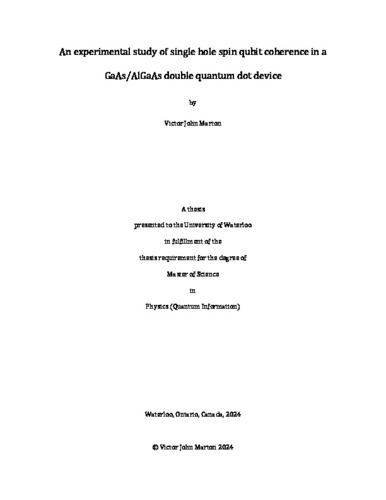| dc.description.abstract | This thesis discusses a series of experiments performed on a p-type laterally-gated GaAs/AlGaAs double quantum dot device. The main purpose of these experiments was to explore the potential of a theoretically-predicted increase in the spin coherence time T_2^* for the usage of a single hole pseudo-spin in GaAs, as opposed to a conduction-band electron.
The “Introduction” section provides a brief overview of the history of the Loss-DiVincenzo spin qubit and the motivation to iterate upon its implementations in light of the DiVincenzo criteria for quantum computing. It also places the experiments in this thesis in context with regard to preceding experiments of a similar nature performed in the same research group.
The “Relevant Background Information” section provides an exploration of a number of topics that aid the non-expert in familiarizing themselves with the principles of semiconductor quantum dots, understanding the functionality of the device and methods used, and interpreting the results of the experiments.
The “Readout” section explains the process by which the single-shot experiments and spin-to-charge readout scheme are prepared, performed, and detected by room-temperature electronics. The process by which the various tunneling times of the system are tuned in order for the pulsing scheme to function is then discussed. Finally, the energy level alignments for successful hole transfer are identified experimentally.
The “Results and Discussion” section presents and describes the results of the various experiments performed in order to fully characterize the coherence characteristics of the device. Following successful spin excitation via EDSR, the state of the hole pseudo-spin was manipulated via Rabi experimentation. Methods for maximizing device performance are motivated, explained, and displayed. The coherence times T_2^* and T_2^CPMG are then determined via Ramsey, Hahn-echo, and CPMG experiments. These results are then discussed and compared to contemporaries. The spin relaxation time T_1 is extracted and compared with previous results on the same device. Finally, an additional functionality is explored in which the dot effective g-factor is tuned electrically via gate voltage pulsing within each single-shot experiment. | en |

